Dream of a Sunday Afternoon in Alameda Central Park Diego Rivera Ap Art History

Diego Rivera, Dream of a Sun Afternoon in Alameda Cardinal Park (Sueño de una tarde dominical en la Alameda Central), 1947, 4.eight x fifteen m (Museo Landscape Diego Rivera, originally, Hotel del Prado, Mexico City; photograph: Fedaro, CC BY-SA 4.0)
Dream or nightmare
In Dream of a Dominicus Afternoon in Alameda Central Park, hundreds of characters from 400 years of Mexican history gather for a stroll through Mexico Urban center's largest park. Just the colorful balloons, impeccably dressed visitors, and vendors with diverse wares cannot conceal the darker side of this dream: a confrontation between an indigenous family unit and a police force officer; a man shooting into the face of someone being trampled by a equus caballus in the midst of a skirmish; a sinister skeleton smiling at the viewer. What kind of dream, or nightmare, is this?
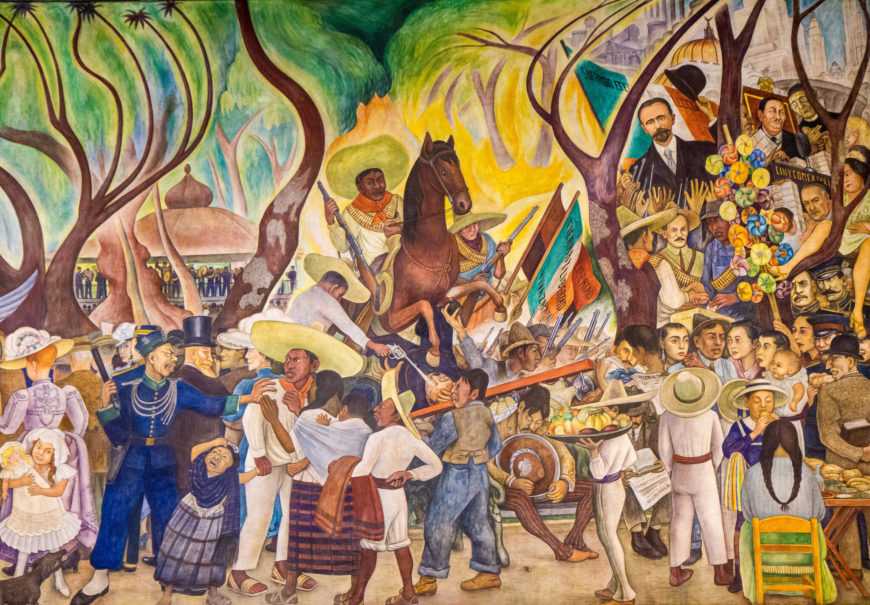
Diego Rivera, detail with rearing horse and shooting, Dream of a Sun Afternoon in Alameda Fundamental Park (Sueño de una tarde dominical en la Alameda Central), 1947, 4.8 10 15 m (Museo Mural Diego Rivera, originally, Hotel del Prado, Mexico City; photo: Garrett Ziegler, CC BY-NC-ND 2.0)
Surreal quartet
In the spirit of Surrealism, this is a complex dream. For Surrealists, like Salvador Dalí, dreams were the principal subject matter. Since dreams are and then personal and foreign, this allowed artists to juxtapose unrelated matter, like clocks and ants for Dalí. Though Rivera never officially joined the Surrealists, he uses this approach in Dream of a Sunday Afternoon in Alameda Central Park as he cobbles together a scene composed of disparate historical personages, including Hernán Cortés (the Spanish conquistador who initiated the fall of the Aztec Empire), Sor Juana (a seventeenth-century nun and one of Mexico's virtually notable writers), and Porfirio Díaz (whose dictatorship at the turn of the twentieth century inspired the Mexican Revolution).
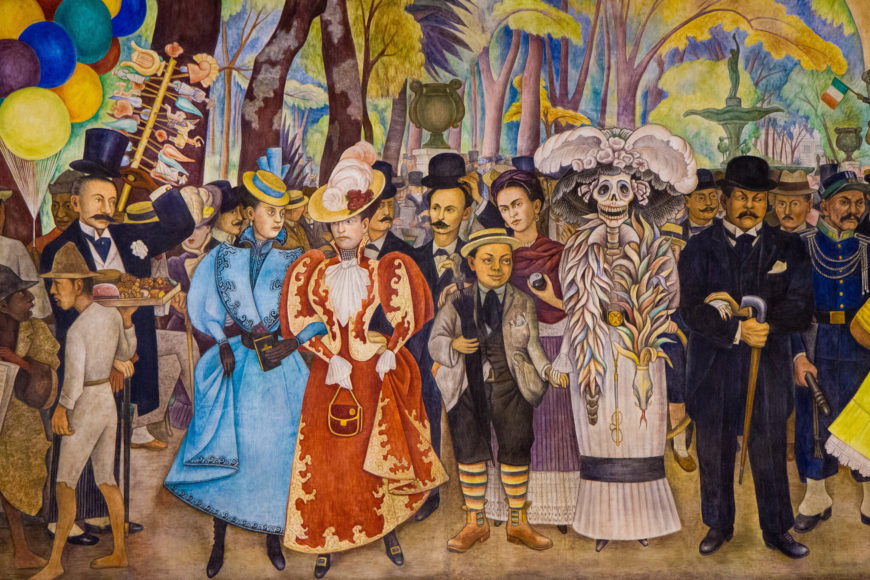
Diego Rivera, detail of central group with four rightmost figures (right to left) being the printmaker José Guadalupe Posada (right), La Catrina (the Skeleton), the painter Frida Kahlo (backside La Catrina), and the creative person equally a young man (in front of Kahlo), Dream of a Dominicus Afternoon in Alameda Central Park (Sueño de una tarde dominical en la Alameda Central), 1947, 4.8 ten 15 k (Museo Mural Diego Rivera, originally, Hotel del Prado, Mexico City; photo: Garrett Ziegler, CC BY-NC-ND two.0)
Perhaps the most hitting grouping is a central quartet featuring Rivera, the artist Frida Kahlo, the printmaker and draughtsman José Guadalupe Posada, and La Catrina. "Catrina" was a nickname in the early twentieth century for an elegant, upper-form woman who dressed in European clothing.
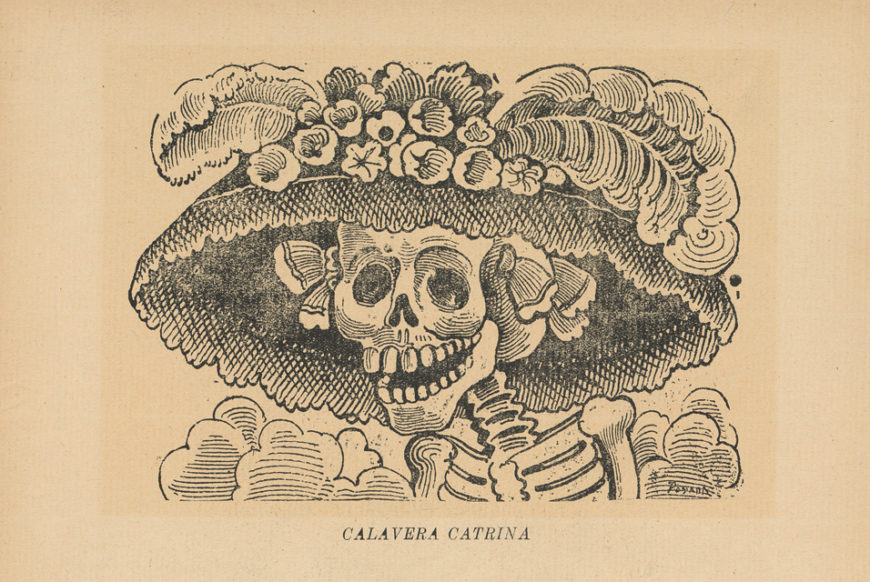
José Guadalupe Posada, La Calavera Catrina, 1913, carving, 34.five x 23 cm (photograph: Wmpearl, public domain)
This character became infamous in Posada's La Calavera de la Catrina (The Catrina Skeleton), 1913. Here, the renowned printmaker depicted La Catrina as a skeleton in order to critique the Mexican aristocracy. In Dream of a Sunday Afternoon in Alameda Primal Park, Rivera reproduces the original Posada print and adds an elaborate boa—reminiscent of the feathered Mesoamerican serpent god Quetzalcóatl—around her neck.
La Catrina unites two great Mexican artists in this landscape: she holds Rivera's hand equally her other arm is held by Posada. Though Posada died in obscurity in 1913, artists after brought attending to his work and he was a significant influence on the Mexican muralists. The fourth character in this quartet is Kahlo. She stands behind a child-version of her husband, with one hand protectively on his shoulder as her other holds a Yin and Yang object.
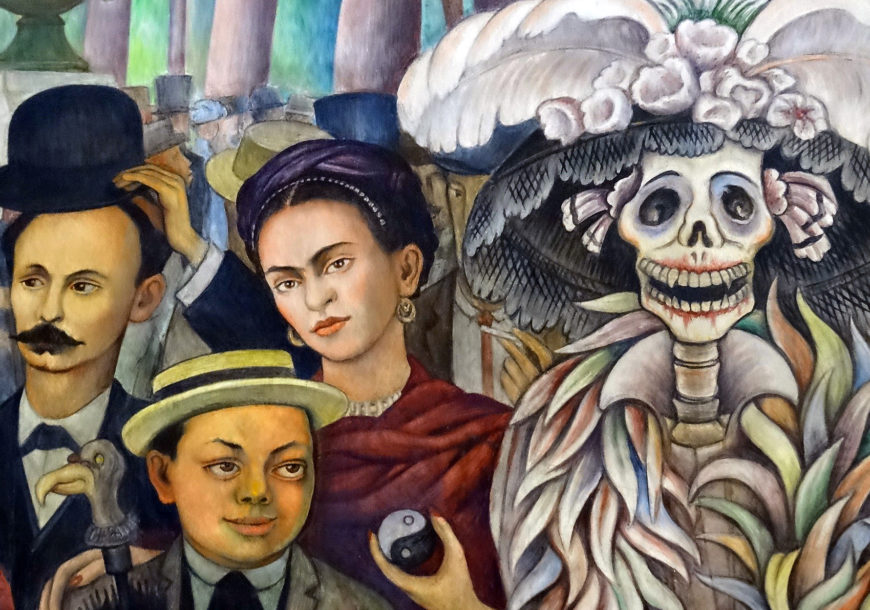
Diego Rivera, item with the artist equally a young man (lower left), the paintier Frida Kahlo (backside him), and La Catrina (the Skeleton), Dream of a Sunday Afternoon in Alameda Primal Park (Sueño de una tarde dominical en la Alameda Cardinal), 1947, 4.8 x xv thou (Museo Landscape Diego Rivera, originally, Hotel del Prado, United mexican states City; photograph: Adam Jones, CC BY-SA 2.0)
In Chinese philosophy, Yin and Yang refers to opposite yet interdependent forces, like 24-hour interval and night. Inside the proper name of this concept is perchance the nearly key duality in humanity: female person ("Yin") and male person ("Yang"). Thus, this Chinese symbol becomes a metaphor for Rivera and Kahlo's complex human relationship: Rivera began as Kahlo'south mentor; they then married, separated, and got dorsum together; they were political comrades; and they painted each other frequently. Their double-portraits often reflect the state of the couple'due south relationship at that moment. In Frieda and Diego Rivera (1931) Kahlo subtly plays with the couple'south stature in order to emphasize Rivera's influence on her. Kahlo was ill equally Rivera worked on this mural and his macerated size may reflect his feelings of helplessness.
Reading Mexican history
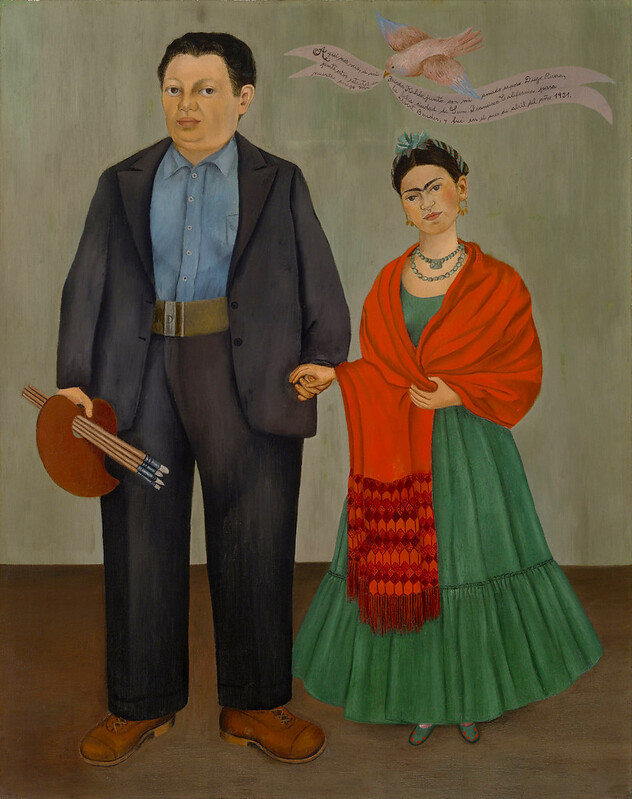
Frida Kahlo, Frieda and Diego Rivera, 1931, oil on canvas, 39–3/8 x 31 inches or 100.01 x 78.74 cm (San Francisco Museum of Modern Art; photo: Lluís Ribes Mateu, CC Past-NC two.0)
Stepping away from the center, if one reads the landscape like a text, a chronology emerges: the left side of the composition highlights the conquest and colonization of Mexico, the fight for independence and the revolution occupy the majority of the central space, and modern achievements fill the correct. For some art historians the central expanse is a snapshot of bourgeois life in 1895—every bit refined ladies and gentlemen promenade in their Sunday best, under the watchful eye of Porfirio Díaz in his plumed armed forces garb. Ane gets a sense of the inequality that stirred average Mexicans to overthrow their dictator and initiate the Mexican Revolution which lasted from 1910 until 1920.
In this light we can appreciate the dreams and nightmares within each epoch. To the left of the balloons the nightmares of the conquest and religious intolerance during the colonial-era give manner to the dream of a autonomous nation during the nineteenth century, represented by the over-sized figure of Benito Juárez, who restored the republic after French occupation and attempted to modernize the country every bit president. On the right of the limerick, across the bandstand, the battles of the revolution requite way to a society where "land and freedom," as championed by the workers' flags, becomes a tangible reality.
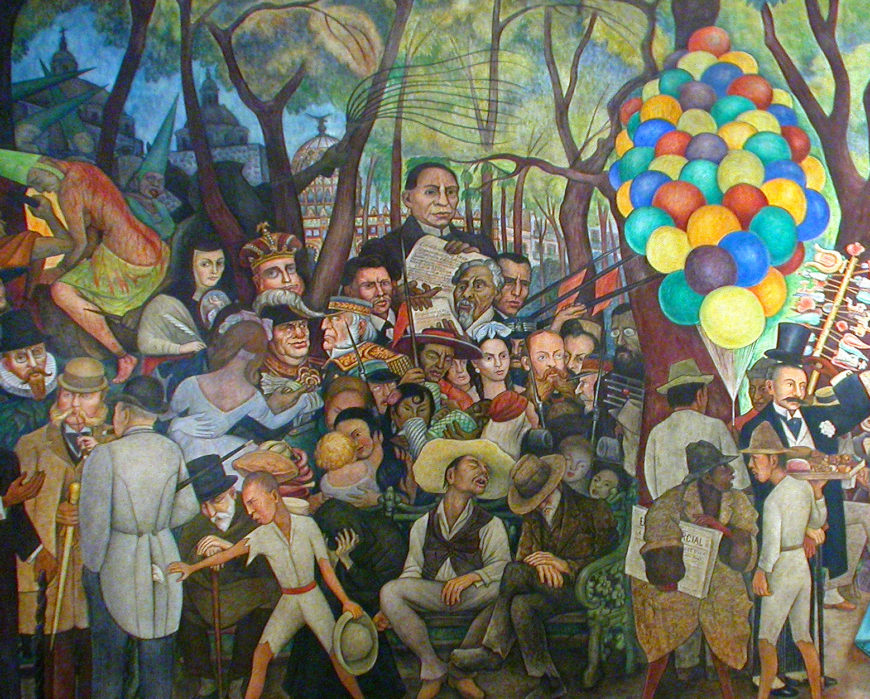
Diego Rivera, particular with Benito Juárez peak center, Dream of a Dominicus Afternoon in Alameda Primal Park (Sueño de una tarde dominical en la Alameda Central), 1947, 4.8 x 15 one thousand (Museo Mural Diego Rivera, originally, Hotel del Prado, Mexico Urban center; photograph: Fedaro, CC BY-SA 4.0)
Histories commonly edited out
More often than not history is written past the victor and thus reflects an incomplete story. Dream of a Sunday Afternoon in Alameda Central Park is an antidote to this: Rivera guarantees that histories normally edited out (the stories of the indigenous and the masses) accept a place in this thousand narrative. The creative person reminds the viewer that the struggles and glory of four centuries of Mexican history are due to the participation of Mexicans from all strata of society.
Additional resources
William Stockton, "Rivera Mural in United mexican states Awaits Its New Shelter" in The New York Times, January. 4, 1987
Source: https://smarthistory.org/rivera-dream-of-a-sunday-afternoon-in-alameda-central-park/
Post a Comment for "Dream of a Sunday Afternoon in Alameda Central Park Diego Rivera Ap Art History"